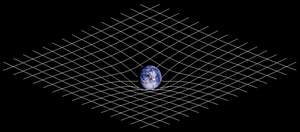Graviton facts for kids
Imagine tiny, tiny particles that carry forces. A graviton is a hypothetical (meaning scientists think it might exist, but haven't seen it yet) particle. It's believed to be the particle that carries the force of gravity. Just like a photon carries light, a graviton would carry gravity.
Scientists call particles that carry forces "gauge bosons". Gravitons are thought to be a type of gauge boson. Even though they haven't been directly seen, many theories in physics use gravitons to explain how gravity works at a very small, quantum level.
Contents
What is a Graviton?
A graviton is a tiny, invisible particle. It's thought to be the smallest unit of gravity. If gravitons exist, they would be responsible for pulling things together. This pull is what we call gravity.
Scientists believe gravitons would have no mass. They would also travel at the speed of light. This is similar to how photons work.
Why Do Scientists Think Gravitons Exist?
Scientists are always trying to understand the universe. They have theories that explain three of the four main forces:
- Electromagnetism (like magnets and electricity)
- Strong force (holds atomic nuclei together)
- Weak force (involved in radioactive decay)
These forces are explained by something called quantum mechanics. Quantum mechanics describes how things work at a very tiny scale. However, gravity is currently explained by general relativity, which works well for large objects like planets and stars.
Scientists want to find a way to combine general relativity with quantum mechanics. This would create a "theory of everything." A graviton is a key part of this idea. It would help explain gravity using quantum mechanics.
How Would Gravitons Work?
Imagine you throw a ball to a friend. The ball carries energy between you. In a similar way, gravitons are thought to carry the force of gravity.
When two objects with mass are near each other, they would exchange gravitons. This exchange would create the pull we feel as gravity. The more mass an object has, the more gravitons it would exchange. This is why bigger objects have stronger gravity.
For example, a large asteroid has more gravity than a small one. This is because it has more atoms. Each atom would contribute to the "population" of gravitons around it.
Gravitons and Black Holes
Some theories suggest that black holes are like giant collections of gravitons. A black hole is a place in space where gravity is so strong that nothing, not even light, can escape.
One theory by Georgi Dvali and Cesar Gomez describes a black hole as "an overpacked bucket of gravitons." This idea tries to combine what we know about black holes with quantum mechanics.
Searching for Gravitons
Finding a graviton is very difficult. They are thought to be incredibly weak. This means they would interact very little with other particles.
Scientists use powerful machines like the Large Hadron Collider at CERN. This machine smashes particles together at very high speeds. By studying the results, scientists hope to find new particles. They are looking for clues that might point to the existence of gravitons.
If a graviton were found, it would be a huge discovery. It could help scientists create a single theory that explains all the forces in the universe.
Images for kids
See also
 In Spanish: Gravitón para niños
In Spanish: Gravitón para niños



